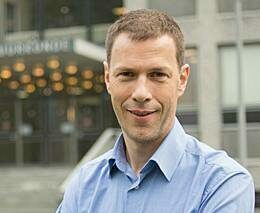Hurdling Towards a Quantum Computing Future
by Alan S. Brown
A conversation with Lieven Vandersypen

The Author
The Dutch Research Council recently awarded Lieven Vandersypen the Spinoza Prize, the highest award in Dutch science. Vandersypen is a member and former director of the Kavli Institute of Nanoscience at Delft University of Technology and research director of QuTech, a research institute that develops quantum computer and quantum internet prototypes, that was founded by TU Delft and the Netherlands Organization for Applied Scientific Research (TNO).

Vandersypen’s career mirrors the development of quantum computing. As a graduate student, he was part of the first team to use the quantum state of atomic nuclei to create a quantum bit, or qubit, the building block of quantum computers. Building on that work, he used the spins of seven nuclei to factor the number 15 into 3 and 5, the first practical demonstration of quantum computing. At Delft, he has advanced the use of electron spins in quantum dots, nanoscale semiconductors small enough to be governed by the laws of quantum mechanics, to isolate electrons and use them for quantum computing.
In this interview, Vandersypen discusses quantum computing’s past and future.
What were you like growing up? Did you always want to be a physicist?
When I was kid, wanted to be either a cowboy or inventor. I would read western novels and then reenact with my cousins or friends. I also read books about famous inventors, admiring how people came up with new things—though I imagined them all sitting in a room together at their desks until one of them had an idea. My parents couldn’t tell me what to study to become a cowboy, so they suggested that I study engineering at university.
After graduating with a degree in mechanical engineering, you began graduate studies in electrical engineering at Stanford University. At the time, quantum computing was on hardly anyone’s mind. What got you interested in this subject?
I had other interests when I began by Ph.D. program at Stanford. Then I met Isaac Chuang, who had finished his Ph.D. at Stanford and was working at Los Alamos National Lab. He would later move to IBM Almaden, where I did most of my experimental work. He was the one who introduced me to quantum computing, and I was blown away. He gave me some things to read, and I literally couldn’t sleep from excitement, so many thoughts were going through my mind.
The field was just starting then, wasn’t it?
This was right at the beginning. Theorists were proposing that quantum computers could outperform classical computers in tasks like factoring integers, speeding up searches, and calculating the properties of molecules and materials. They were also putting forward the very first ideas of how you would build such a machine. Part of the attraction for me was that I could join a research field that was just starting, at least on the experimental side.
You played a key role in demonstrating that we could link the nuclei in molecules and use their spins—how they orient themselves in a magnetic field—to factor a number. Could you talk a little about that?
Using the spins of nuclei in molecules as qubits was one of the earliest ideas of how to build a prototype quantum computer. Ike Chuang was part of a group that wanted to use nuclear magnetic resonance to do that and invited me to join them.
Using nuclear magnetic resonance was a very good way to quickly begin experimenting with the principles of quantum computing using a technology that was already in place. For decades, researchers had used it to manipulate and study nuclear spins. It was well known that nuclear spins had really long coherence times, meaning that they remained in their desired quantum state for one to 10 seconds.
It was clear from the beginning that we could never build enough qubits for a quantum computer this way. But we could use NMR to learn how to manipulate increasing numbers of spins—first two, then three, then five, and then seven—and take them through the steps of quantum algorithms of increasing complexity.
You did just that, using the spins of seven atomic nuclei to factor 15. How did you do it?
We created a molecule with seven atoms that had nuclear spins that could act as qubits. We took those seven spins through a quantum algorithm developed by Peter Shor to factor 15 into three and five. The first time we tried to run the algorithm, the spectral lines we used to measure our output were lousy. Over time, as we improved our control techniques, the output got better and better, until the coherence of the spins became the limiting issue. Along the way, we learned a lot about control that was later adopted by other qubit technologies.
From atomic spins, you moved onto quantum dots. What was the attraction?
By then, I was reading the literature and looking for something that could scale. There were several contenders, but I was attracted to electron spins in semiconductors for two reasons. First, with semiconductors, there’s a lot you can do aside from quantum computing that that would be interesting to me. Second, I was starting to see papers from people who had isolated an individual electron inside a single quantum dot. One of the names that I kept coming across was that of Leo Kouwenhoven of Delft University of Technology. Then I spoke with him at a conference and learned that he had funding to study quantum computing, and so I decided to join his group as a post-doc. I came to Delft in 2001 and, with some other members of his group, started a project to use semiconductor quantum dots for quantum computing.
Recently, there has been a tremendous surge in interest in quantum computing. What led to it?
It’s not often that researchers demonstrate a novel idea with such great potential. This has attracted a lot of big industry players. Even though realizing quantum computing is far away and many obstacles remain, the potential is so large that they are willing to invest in big research programs to move things forward. For example, my team began working closely with Intel more than six years ago to make quantum dots with greater uniformity and higher yields. They were very supportive, and the collaboration increased the working devices we could use for our experiments.
This was right around the time Delft founded QuTech, whose mission is to develop scalable prototypes of quantum computers. What makes it different from what you were doing before?
While it was quite remarkable what my colleagues and I could do in our separate labs, it was also clear that if we wanted to stay at the forefront in this field, we would need to start working in a different way. We could not rely on just individual researchers and laboratories. We needed larger efforts that spanned different disciplines. We also thought it would be helpful to go beyond academics, who worry about their next publication or their Ph.D. thesis. We needed industry professionals who had a different mindset and knew how to build a technology platform that will lead to further advances.
Will our quantum future be disruptive? Will it change the world?
We have to prove ourselves as a field, but the potential is there. If we manage to make large-scale machines, we will be able to efficiently compute the properties of molecules and materials, which is impossible otherwise, and from there accelerate the design of more efficient batteries and solar cells, superconductors that work at room temperature, and new medications and catalysts. And that is just the start.
So, final question: Do you sometimes look back and wish you had become a cowboy instead of an engineer?
That’s a good question, but I have no regrets. I also think there is a little bit of overlap between those two. What attracted me to cowboys was their pioneering spirit, going to the Wild West where no one had gone before. That’s what we do in the scientific community. We go into uncharted territory, and that can be a big adventure, too.